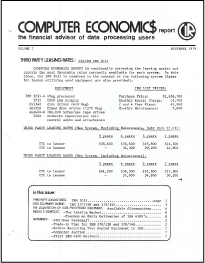 After 36 years in print, Computer Economics announced today that it will end publication of its monthly journal, the Computer Economics Report, with its December 2014 issue. As has been the case for many years, all research printed in the CER will continue to be available through the firm’s website at https://avasant.com/research/computereconomics.
After 36 years in print, Computer Economics announced today that it will end publication of its monthly journal, the Computer Economics Report, with its December 2014 issue. As has been the case for many years, all research printed in the CER will continue to be available through the firm’s website at https://avasant.com/research/computereconomics.
Computer Economics, Then and Now
Computer Economics founder Bruno Bassi published the first issue of the CER in November 1979, a complimentary copy of which can be downloaded from the Computer Economics website. News covered in that first issue provides a glimpse at changes in the IT industry that have taken place over nearly four decades:
- Leasing rates for IBM System 3031 mainframes. Although current prices for IBM mainframes were difficult to obtain, Computer Economics was able to aggragate this information and make it available to buyers and lessors. In that first issue, Computer Economics disclosed that the purchase price of an IBM 3031-4 mainframe configuration was over $1.6 million, but you could lease it for five years for approximately $30,000 a month.
- IBM goes personal? Computer Economics predicted that IBM would enter the personal computer market as early as the end of the year with its “Entry Level System,” priced at about $4,500. The prediction was a bit premature. The IBM PC eventually hit the market a year and a half later, in August 1981.
- The acquisition of data processing equipment. The inaugural issue of the CER included the first of three articles outlining the decision-making process for acquiring computer hardware. The first article included a description of the various leasing options generally available.
- How to get early delivery on IBM 4300 mainframes. There was a huge demand for this new generation of IBM equipment, and Computer Economics outlined how it was possible to pay a premium to get early delivery. This article also summarized the most favorable deal that Computer Economics was able to identify for a lease of this equipment.
Now, almost four decades later, Computer Economics continues to provide information on IT equipment, with its publication of vendor hardware discounts, fair market values, and residual value forecasts. Although Computer Economics was heavily oriented toward computer hardware in those early years, the firm also provided research on other categories of IT spending. The second issue of the CER included average IT salaries for systems analysts as well as typical pay rates for IT contracts. Computer Economics continues its publication of similar data today with its annual IT Salary Report.
The biggest change in Computer Economics research coverage, however, came in 1990, when the firm initiated its annual IT Spending and Staffing Benchmarks study, based on an annual survey of IT organizations in the U.S. and Canada. This study remains a leading, definitive source of IT spending and staffing benchmarks today.
Shift to Digital
From 1979 to the late-1990s, Computer Economics continued to expand its newsletter business, eventually publishing as many as 14 newsletters on a monthly or bi-monthly basis. Titles included the original CER, as well as specialized titles, such as the Digital Systems Report, the Systems Reengineering Newsletter, the Client/Server Economics Letter, Open Systems Economics, the Digital Directions Report, and the Software Economics Letter. All these were delivered in print, though Computer Economics for a short time also delivered a daily fax update to subscribers.
In the mid-1990s, the Internet was emerging as a commercial platform, and Computer Economics was quick to realize its potential. It began by publishing several newsletters, such as Internet and Networking Strategies, the Web Marketing Update, and Internet Marketing Technology. Shortly thereafter, the firm launched its first website at https://avasant.com/research/computereconomics and began offering website subscriptions.
A search of the Internet archives shows the first appearance of the Computer Economics website in late 1996. For the first few years, the website only offered customers the ability to sign up as print or CD-ROM subscribers. That changed, however, in the late 1990s when Computer Economics began to offer web subscriptions for access to research. Existing clients as well as new clients—including large IT consulting and accounting firms—found digital delivery and the ability to search the Computer Economics research library more convenient than the print medium. No longer restricted by newsletter page counts, it allowed Computer Economics to increase the content of each report.
From this point, subscriber preferences moved rapidly away from print to digital-only delivery. By the turn of the century, most of the newsletters were dropped, and when new ownership acquired the firm in 2005 only the flagship print publication, the Computer Economics Report, remained.
By that time, the print newsletter accounted for less than 5% of Computer Economics revenue and most of the monthly print run consisted of complimentary copies distributed to survey respondents. With the discontinuation of print publications, we are now electronically delivering complimentary “report of the month” research to our survey respondents.
The Future of Computer Economics
Information technology is a fast-moving, ever-changing industry. Yet for nearly four decades, Computer Economics has continued to serve the needs of IT executives. While information technology is continually changing, the economic challenges that come with managing IT remain largely the same. Today, as in 1979, IT executives need to align their IT strategy with business strategy. Today, as then, organizations are concerned about the cost of IT and ensuring a return on investment. They want to know how their spending and staffing levels compare with peer organizations, and they want to know about the experiences of others in implementing and managing new technologies. As long as businesses use information technology, there will always be a need to understand the economics of IT.

